Disclosure: This post may contain affiliate links. I may earn a small commission for my endorsement, recommendation, testimonial, and/or link to any products or services from this website.
With just 5 ingredients and about 10 minutes of hands-on prep, you can bake a loaf of crusty no knead Dutch Oven Bread! This quick recipe doesn’t need to rest overnight, so you can enjoy the artisan bread on the same day that you stir it together.
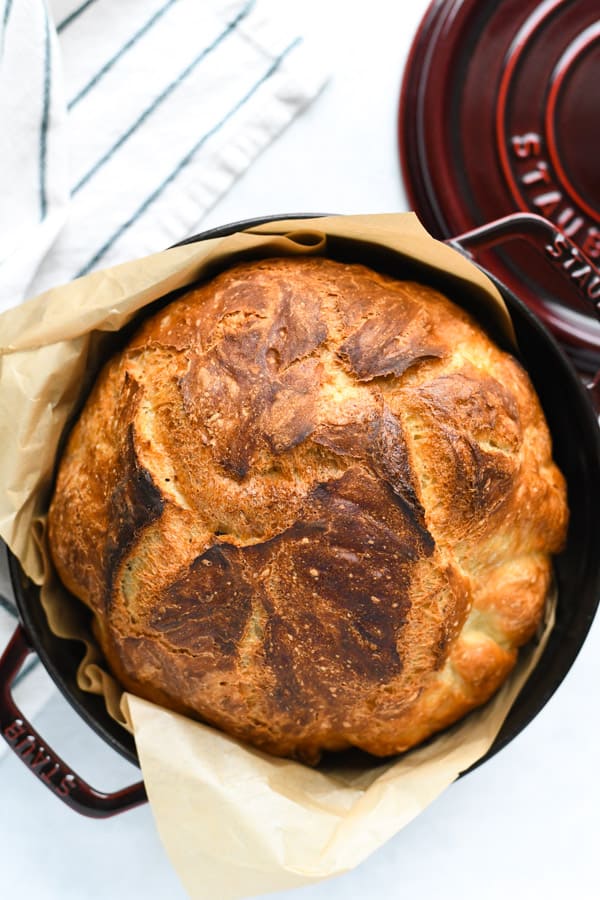
Table of Contents
- How to Make No Knead Dutch Oven Bread | 1-Minute Video
- The Difference Between Knead and No-Knead Dutch Oven Bread Recipes
- A Dutch Oven is the Best Way to Bake No-Knead Bread
- The Best Dutch Oven for Baking Bread
- Ingredients for Cast Iron Dutch Oven Bread
- How to Make Bread in a Dutch Oven
- What to Serve with this No Knead Dutch Oven Bread Recipe
- Storage
- Easy Dutch Oven Bread Recipe Variations
- Tips for the Best Dutch Oven Bread Recipes
- Dutch Oven Bread {No Knead!} Recipe
If you love homemade bread recipes, be sure to try this jalapeno cheddar bread, this classic white bread with milk and honey, and this farmhouse oatmeal bread, too!
How to Make No Knead Dutch Oven Bread | 1-Minute Video
We’ve been enjoying my overnight no-knead bread for ages, and that simple recipe still produces a delicious loaf. The only problem? You need to remember to prep the dough the day before you actually plan to bake it. Sometimes I’m not quite that organized, so this quick 3-hour version of no-knead Dutch Oven bread comes in very handy! Thanks to the magic of a Dutch oven, the crust gets perfectly browned and chewy, while the crumb stays light and airy. No baking experience necessary!
My dad created this recipe for the perfect loaf of same-day homemade artisan bread. It has the taste and texture of classic French bread — a chewy crust and a light, tender crumb, but it doesn’t require a mixer, kneading, or an overnight rest. It’s a quick Dutch Oven bread that’s a perfect companion for a warm bowl of soup, an ideal vehicle for a grilled cheese sandwich, or the best piece of morning toast!
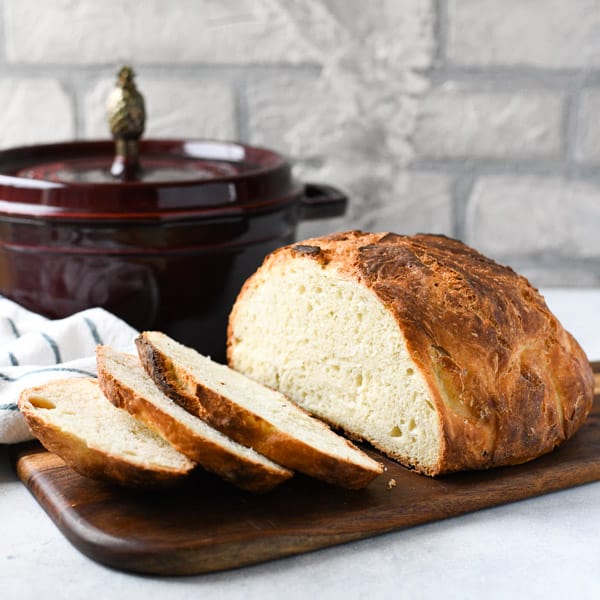
The Difference Between Knead and No-Knead Dutch Oven Bread Recipes
Traditionally, we knead bread dough in order to form gluten. Gluten is a combination of water with two proteins found in wheat flour (glutenin and gliadin). Folding, stretching, and kneading the dough develops various connections between the proteins. The more you knead the flour, the more gluten develops. Well-developed gluten allows the yeasted dough to stretch and expand as it rises. Proper kneading also produces a finer grain or texture in breads.
With that said, you’re probably wondering how it’s possible to bake a loaf of bread without kneading! The difference is that a no knead bread recipe creates a very wet dough. This wet dough allows the glutenin and gliadin proteins to float around on their own, therefore forming gluten on their own, and thus eliminating “the need for kneading!”
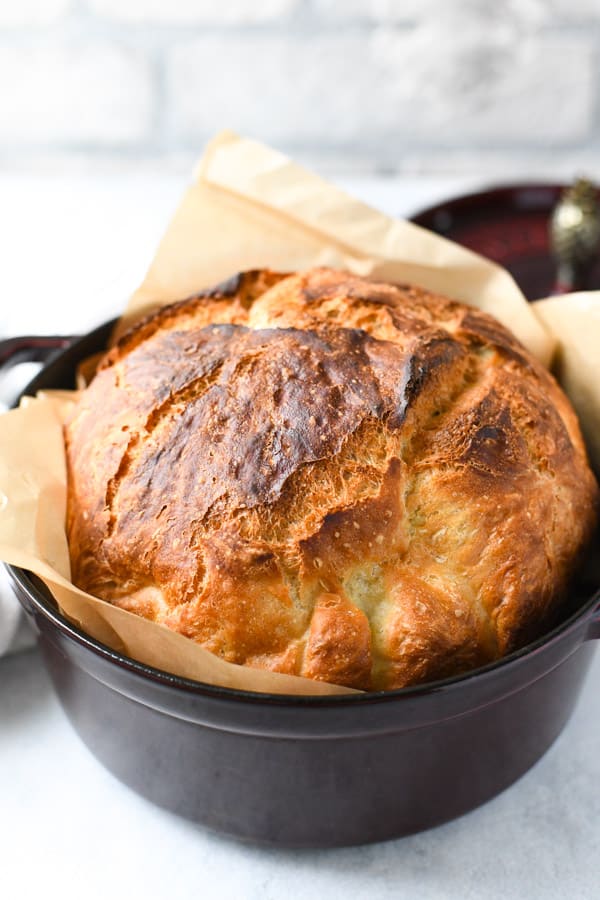
A Dutch Oven is the Best Way to Bake No-Knead Bread
The cast iron Dutch oven is an essential tool for creating a loaf of crispy, crusty, golden, artisan-style bread. When unbaked dough, with all its interior moisture, is put inside the hot pot, humidity is captured in the form of steam. The steam gets trapped inside with the Dutch oven’s tight-fitting lid, which keeps the crust soft longer, so it can continue to expand during the early stages of baking. Additionally, the steam hitting the bread’s surface gelatinizes some of the starches there, which swell and become glossy, creating a crust with subtle luster. The end result is a loaf of artisan bread with a crackly crust and a glossy surface that’s beautifully blistered with bubbles.
The steam created in the Dutch oven also yields a better-tasting loaf of bread. The moisture in the pot keeps the surface of the dough cool for a longer amount of time as the loaf bakes, which allows enzymes (from the yeast) to continue reducing the starches in the flour to simple sugars. These sugars caramelize and create the golden crust and irresistible flavor of a perfectly baked loaf of bread.
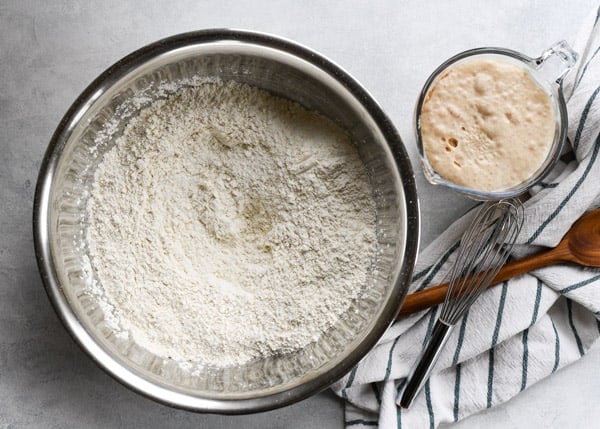
The Best Dutch Oven for Baking Bread
An enameled cast iron Dutch oven is my top choice for baking a loaf of bread. The heavy-duty pots distribute heat evenly and have a tight-fitting lid that efficiently traps the steam. You’ll need a 4 – 6-quart Dutch oven for this recipe. I love the 4-quart Staub Dutch oven, the 5 ½-quart Staub Dutch oven, and the 5 ½ -quart Le Creuset Dutch oven, which are heirloom pieces of cookware that will last you a lifetime. Le Creuset now offers a cast iron bread baker that’s specifically designed for Dutch oven bread recipes, too! For a more budget-friendly option, the Lodge Enameled Cast Iron Dutch oven also has a good reputation.
I’ve tested my dad’s recipe in a larger 6-quart cast iron pot and in the smaller 4-quart pot, and I find that the smaller Dutch oven yields a higher, rounder loaf. The larger Dutch ovens have a larger surface area, which allows the wet dough to spread more in the pot, so the loaf is wider, but not as tall. It will still taste good, but the loaf will have a different shape.
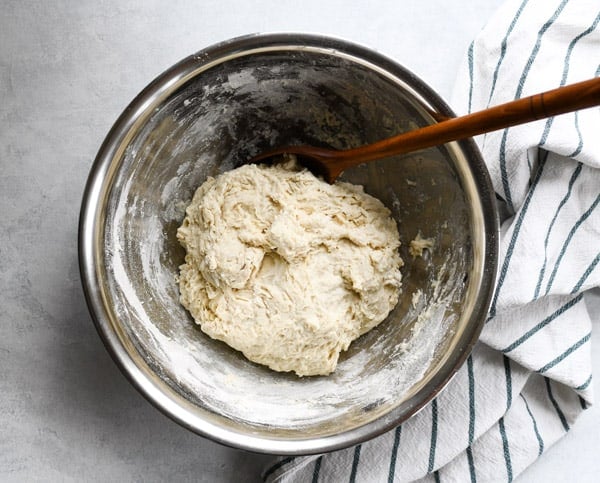
Do I need to preheat the Dutch oven for bread?
Yes! While your dough is rising for the second time, you’ll need to place the Dutch oven (with the lid on) in a cold oven. Preheat the oven to 470°F while the pot is inside. You want the Dutch oven incredibly hot when you add the dough, since the heat of the Dutch oven reacts with the wet dough to create the steam that’s essential for a good loaf of no-knead bread.
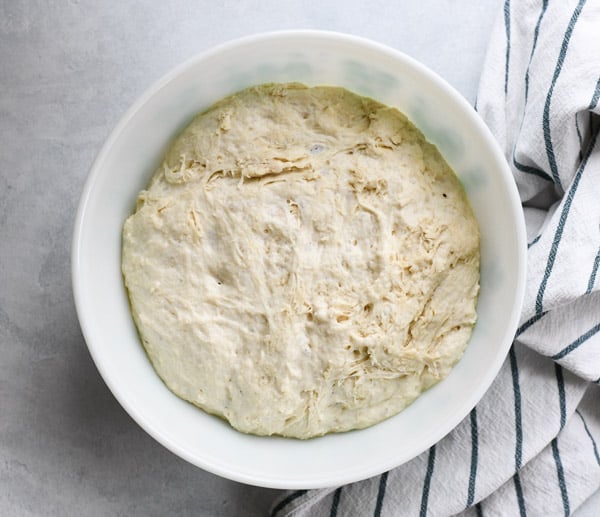
Should I oil my Dutch oven for bread?
No, you do not need to grease or oil the Dutch oven. The cast iron is naturally nonstick, and the dough goes into the pot on a sheet of parchment paper — so you shouldn’t have any issue with sticking. Plus, the extremely high oven temperature will just burn any fat or grease that you put in the Dutch oven.
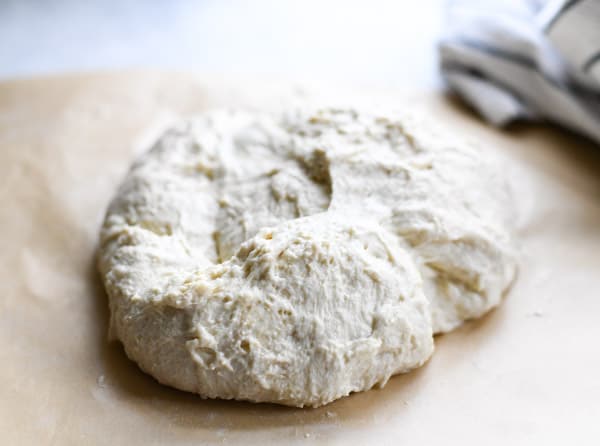
Ingredients for Cast Iron Dutch Oven Bread
This is just an overview of the ingredients that you’ll need for the quick 3 hour no knead bread. As always, specific measurements and complete cooking instructions are included in the printable recipe box at the bottom of the post.
- Flour: all-purpose flour or bread flour will both work. Bread flour tends to yield a slightly higher rise, but either option is great.
- Active dry yeast: the leavening agent that helps the bread rise.
- Warm water: to dissolve and activate the yeast. Make sure that it’s not too hot and not too cool — somewhere in the range of about 105˚-110˚F is ideal.
- Sugar: feeds the yeast.
- Kosher salt: for flavor. Reduce the amount of salt to 1 ½ – 2 teaspoons if you prefer a less salty loaf.
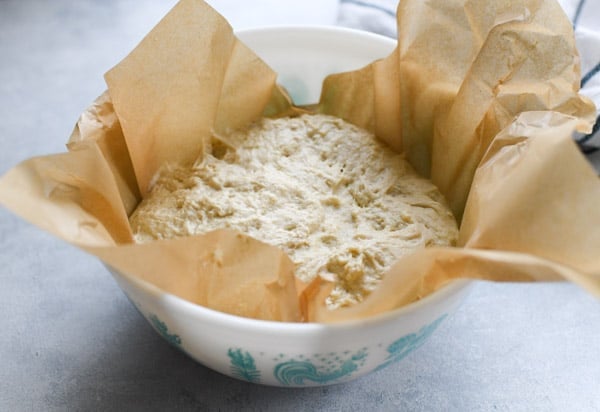
How to Make Bread in a Dutch Oven
This easy Dutch oven bread comes together with about 10 minutes of total hands-on time and a 3-hour rise. There’s no kneading and no stand mixer necessary. It’s simple, delicious, and always perfect!
- Stir together water, yeast, and sugar. Let the mixture sit for 5-10 minutes.
- In a large bowl, whisk together the flour and salt.
- Pour the yeast mixture into the flour mixture and use a wooden spoon to combine. A shaggy dough should come together and pull away from the sides of the bowl. If it’s too wet and sticking to the bowl, add a little bit more flour. If it’s too dry and you still have pockets of flour, add slightly more water.
- Transfer the dough to a greased bowl, cover, and let rise in a warm spot until doubled in size — about 1 ½ – 2 hours.
- Nudge the dough from the bowl with your hand or spatula and dump it onto a piece of parchment paper that you lightly sprinkle with flour. Form the dough into a loose ball by gently folding in the edges. I pat my hands with flour since the dough is very sticky. Don’t stress — this doesn’t have to be perfect. We’re making a rustic loaf of bread!
- Lift the parchment paper and dough ball into a smaller bowl. Cover with a kitchen towel or with plastic wrap and let the dough rise again for about 60 minutes.
- Preheat the Dutch oven in the oven to a temperature of 470°F.
- Transfer the dough to the hot Dutch oven, cover with the lid, and bake for 30 minutes.
- Remove the lid and continue baking until the bread is golden brown on top, about 10 more minutes.
- Cool on a wire rack for at least 1 hour before slicing with a sharp knife and serving.
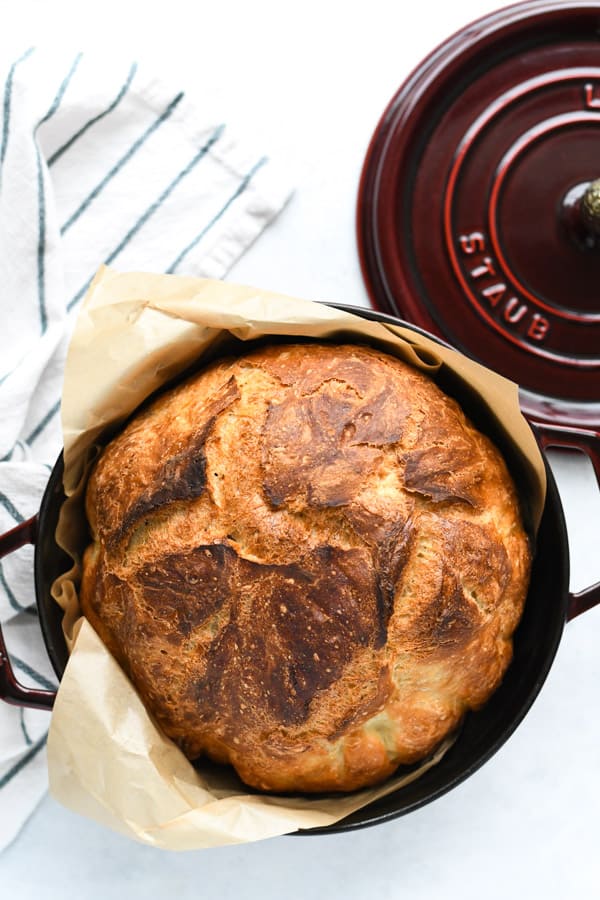
What to Serve with this No Knead Dutch Oven Bread Recipe
A warm slice of this quick Dutch oven bread is perfect when slathered in butter for breakfast, lunch, dinner, or snack! For a quick morning meal, the toasted bread is also great with jam, peanut butter, or a drizzle of honey and flaked sea salt.
If you’re serving the crusty bread alongside your dinner, pair it with a soup, chili, stew, or saucy-dish so that you can use the crusty artisan bread to soak up any extra liquid. Here are a few good options:
- Coq au Vin
- Beef Chili
- Chicken Gnocchi Soup, Italian Wedding Soup, Creamy Cauliflower Soup, or Chicken Vegetable Soup
- Whole Roasted Chicken
- Pasta with Sausage and Spinach
- Lemon Chicken Piccata
- Easy Cassoulet
- Dutch Oven Beef Stew
- Spaghetti Bolognese or Italian Sausage Pasta
- Hungarian Goulash
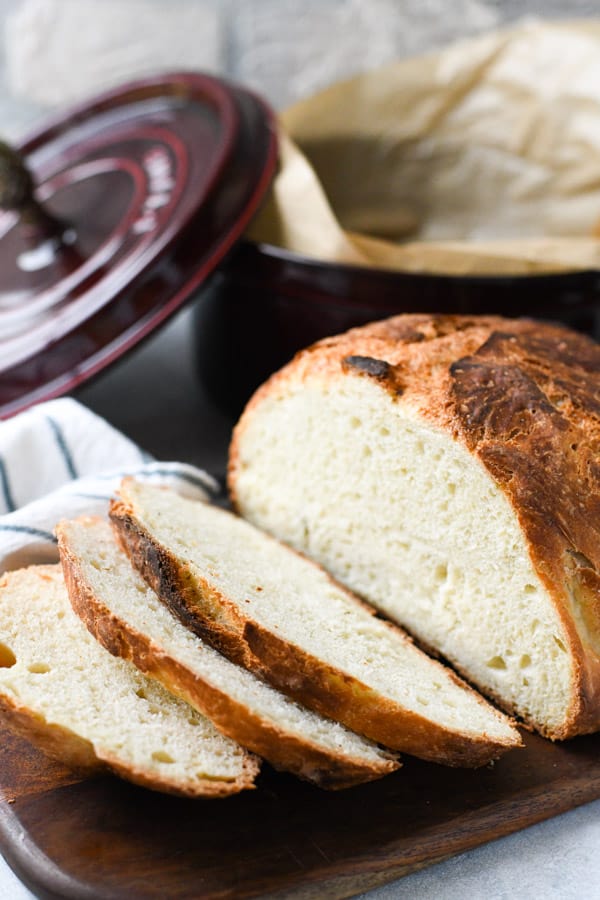
Storage
These classic Dutch oven bread recipes are called “lean breads” because they do not include any added fat to keep them soft and moist. As a result, they dry out quickly and are best enjoyed on the same day that they’re baked. You can store the whole loaf of bread wrapped tightly in plastic at room temperature for 1-2 days, but the crust will be less crispy. To keep the crust crispy, store the bread in an open paper bag at room temperature. Day-old bread is delicious when toasted for breakfast!
To extend the life of your bread, you can wrap the loaf tightly and freeze for up to 2 months.
How to Freeze the Dough
Prepare the dough as instructed and let it rise for 1 ½ – 2 hours, until doubled in size. Form the dough into a loose ball, wrap it in greased plastic wrap, and place the dough in a freezer-friendly container. Freeze the dough for up to 2 months. When ready to bake, allow the dough to come to room temperature for 2-3 hours on the counter (covered) and to perform its second rise, and then bake as directed.
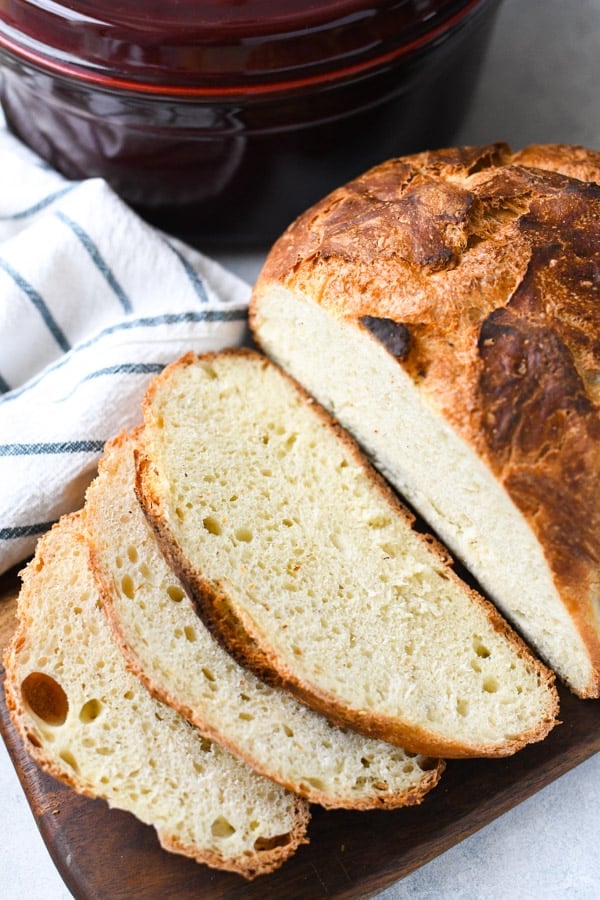
Easy Dutch Oven Bread Recipe Variations
- Bread Flour vs. All-Purpose Flour: All-purpose flour has between 8 and 11 percent protein, while bread flour contains between 12 and 14 percent protein. The extra protein in bread flour results in a slightly higher rise, but all-purpose flour works well in this recipe, too. In short, use whatever you have on hand!
- Instant Yeast vs. Active Dry Yeast: This recipe calls for active dry yeast, which must be dissolved in warm water (“proofed”) before combining with other ingredients. By contrast, instant (or rapid-rise) yeast can be added directly to your dough. I have only used active dry yeast for testing this recipe; however, Cook’s Illustrated has a great article with instructions on how to substitute instant (or rapid rise) yeast for active dry yeast, if necessary.
- Add cheeses (such as Parmesan cheese or grated cheddar cheese), garlic powder, or herbs such as rosemary, chives, or thyme for even more flavor in your loaf.
- For added whole grains, substitute whole wheat flour for some of the bread flour or all-purpose flour called for in this recipe. Whole wheat flour is similar to bread flour in that it contains about 14 percent protein.
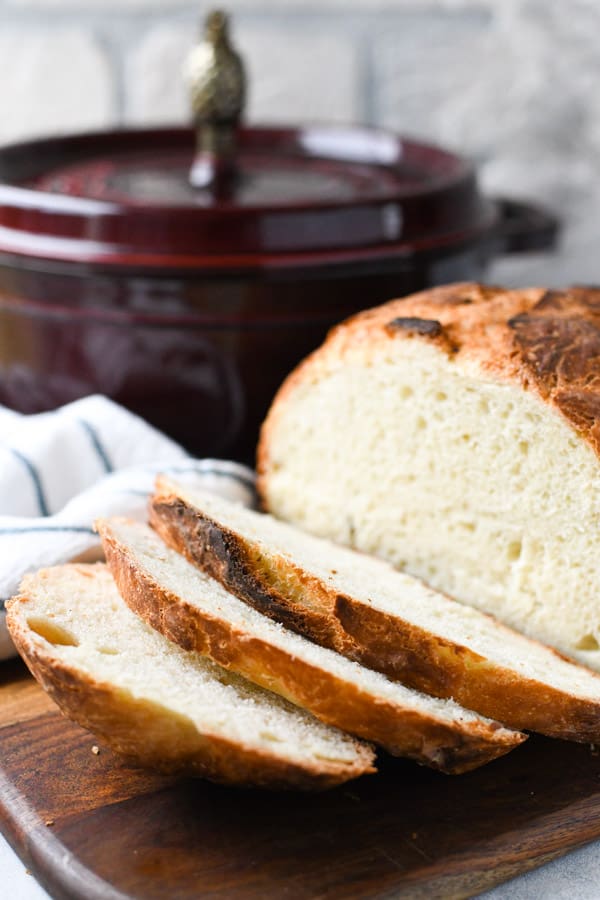
Tips for the Best Dutch Oven Bread Recipes
- Use warm water when preparing the dough — not too hot and not too cold. You want the water to feel like warm bath water (about 105˚-110˚F). If it’s too hot you will kill the yeast; too cold and the yeast will not be activated.
- If your no-knead bread does not rise, it could be due to any number of reasons. For instance, your yeast may not be fresh. Even with a good expiration date, yeast has a short shelf life once a package is opened (I recommend keeping it in the freezer). It’s also possible that your water was the wrong temperature (see my note above regarding water temp).
- Rise in a warm spot. If your dough isn’t rising, check the temperature of your kitchen. You want a warm spot that’s about 70-75°F.
- If the inside of your bread is dense and gummy, this is likely the result of two main culprits. First, the dough may not have proofed long enough to give the gluten a chance to fully develop. Alternatively, the bread may not be cooked through all of the way. When the bread comes out of the oven, it’s still “cooking” and steaming. That’s why it’s important to wait and let the bread sit for at least an hour before slicing into it. You’re looking for an internal temperature of approximately 200°F.
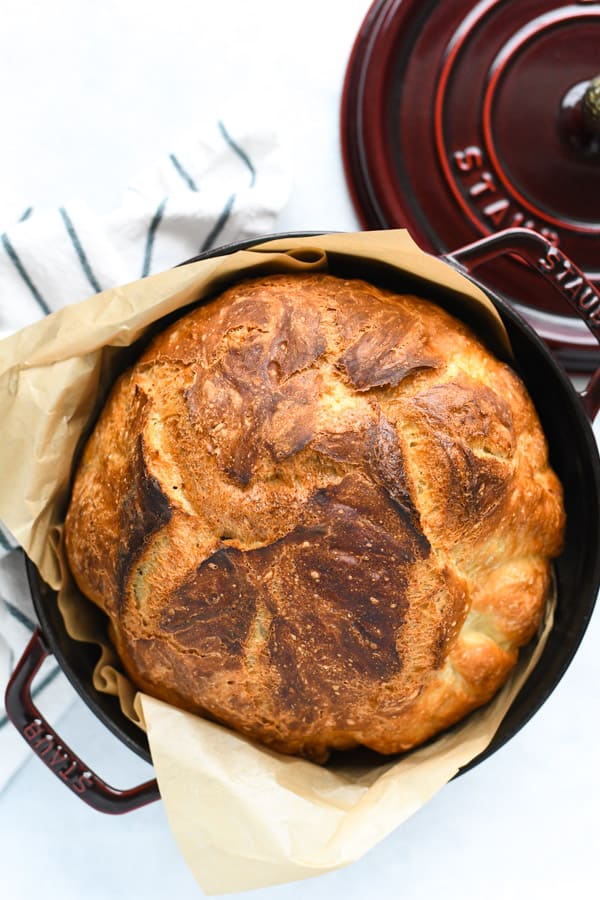
More No Knead Bread Recipes to Try
No-Knead Cast Iron Focaccia
2 hours hrs 30 minutes mins
Cranberry Walnut No Knead Bread
19 hours hrs 45 minutes mins
English Muffin Bread {No Knead!}
1 hour hr 22 minutes mins

Dutch Oven Bread {No Knead!}
Equipment
Ingredients
- 2 cups warm water (about 105˚-110˚F)
- 1 (0.25 oz) envelope active dry yeast (about 2 ¼ teaspoons)
- 1 tablespoon sugar
- 4 cups all-purpose flour or bread flour
- 1 tablespoon kosher salt (reduce to 1½ – 2 teaspoons if you prefer a less-salty loaf)
Instructions
- In a large measuring cup or medium bowl, stir together the warm water, yeast and sugar. Set aside for 5-10 minutes while the yeast softens and becomes foamy. Meanwhile, in a large bowl, whisk together the flour and salt.
- Make a well in the center of the flour mixture. Pour the water and yeast mixture into the well and use a wooden spoon to combine until a shaggy, rough dough comes together and pulls away from the sides of the bowl. If the dough is too sticky, add more flour in small increments, about 1 tablespoon at a time. If the dough is too dry, add more water, 1 tablespoon at a time.
- Transfer the dough to a greased bowl, cover, and leave in a warm spot to rise until doubled in size, about 1 ½ – 2 hours.
- Dust a piece of parchment paper with flour. Nudge the dough from the bowl and dump it onto the floured parchment paper. Form the dough into a loose ball by gently folding in the edges. I pat my hands with flour since the dough is very sticky. Don’t stress — this doesn’t have to be perfect. We’re making a rustic loaf of bread!
- Lift the parchment paper and dough into another smaller bowl. Cover the bowl and let rise for about 30-60 minutes.
- While the dough is rising for the second time, place a 4-6 quart cast iron Dutch oven with its lid into the oven. Preheat the oven to 470°F. When the oven reaches temperature and the dough has risen for the second time, carefully remove the Dutch oven from the oven. Transfer the dough from the bowl to the Dutch oven using the edges of the parchment paper to lift the dough. Cover with the lid. Bake the bread for 30 minutes with the lid on the Dutch oven. Remove the lid and bake for an additional 10-15 minutes until crust is nicely browned (keep a close eye on it).
- Remove the bread from the Dutch oven carefully (it’s still very hot) and place on a cooling rack. Allow to cool for at least one hour before slicing.
Video
Notes
- Bread flour yields a slightly higher rise, but all-purpose flour will also work fine. Use whichever you have on hand!
- If the inside of your bread is dense and gummy, this is likely the result of two main culprits. First, the dough may not have proofed long enough to give the gluten a chance to fully develop. Alternatively, the bread may not be cooked through all of the way. When the bread comes out of the oven, it’s still “cooking” and steaming. That’s why it’s important to wait and let the bread sit for at least an hour before slicing into it.
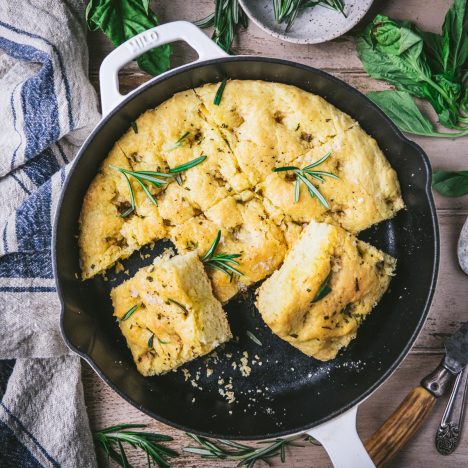
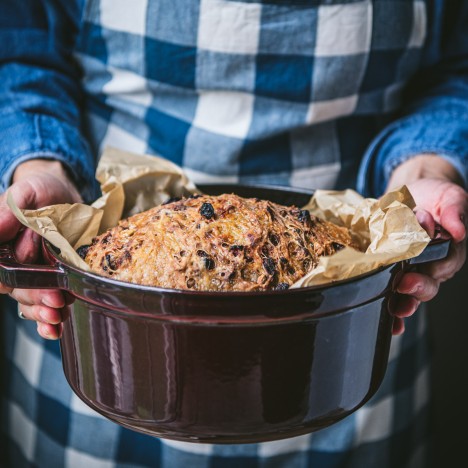
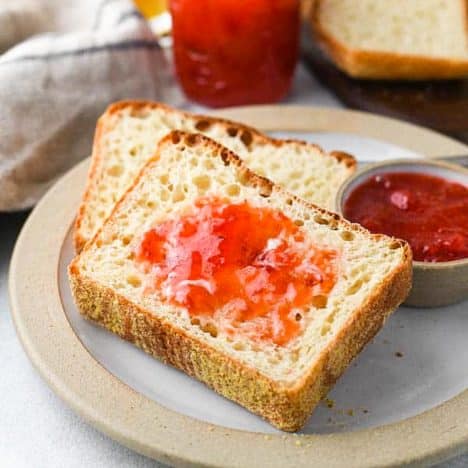






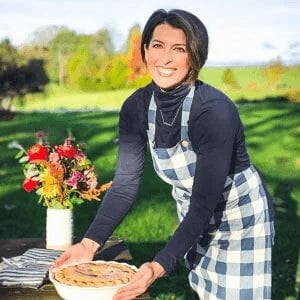
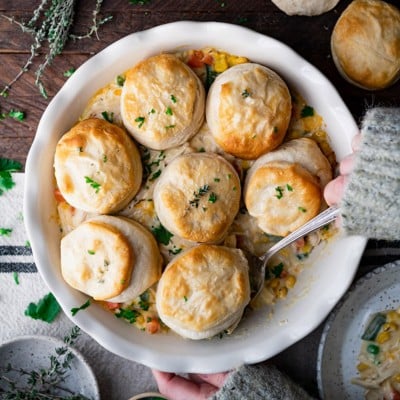
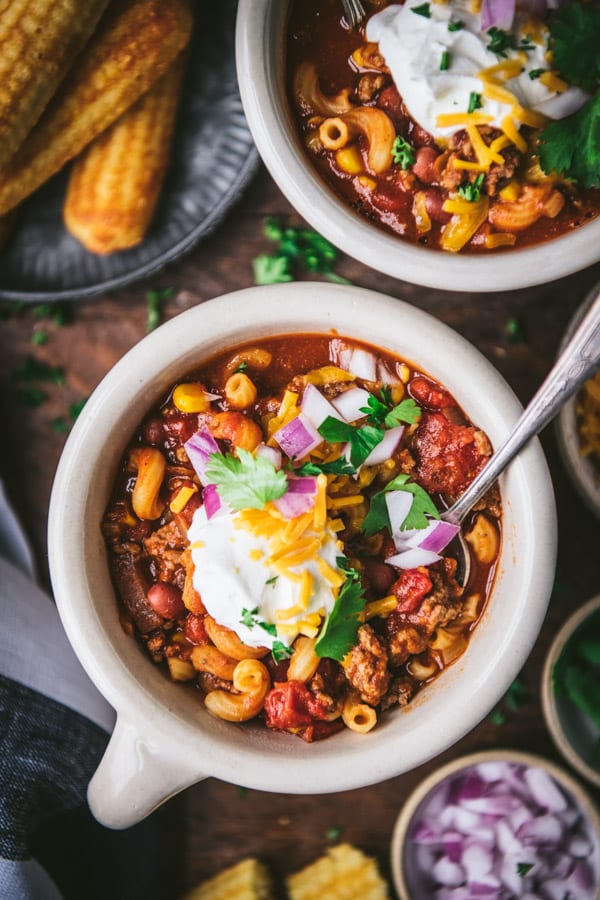
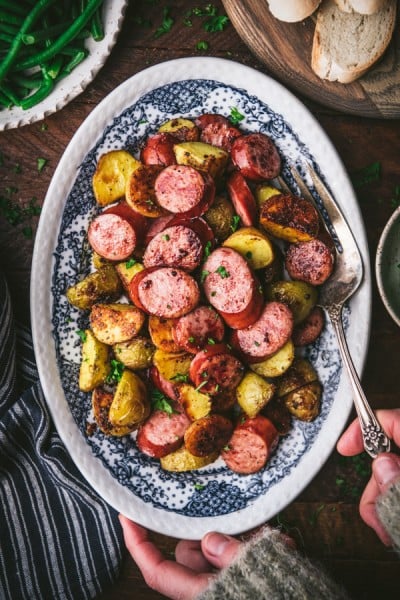








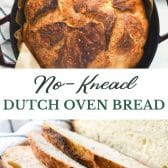
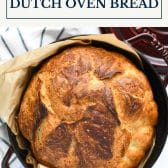
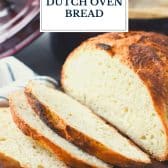
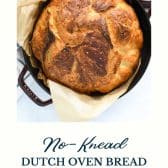
Thank you I’ve been looking for this recipe.
Wonderful! I hope you love it, Kat!
I don’t have a cast iron Dutch oven. Could this be cooked in a regular loaf bread dish? Would it be at the same temperature. Should I cover the bread as it cooks? Thank you
Hi, Dee! No, I don’t recommend baking this type of no-knead bread in a loaf pan. I explain the science of the Dutch oven in the post above, but essentially you need the high heat of the pre-heated Dutch oven (or other heavy-duty lidded pot) to create steam when it reacts with the moist dough. The lid on the pot traps the steam, resulting in the crusty, golden brown bread. If you’re looking for a more traditional white bread recipe that bakes in a loaf pan, this is my favorite: https://www.theseasonedmom.com/easy-homemade-bread/
Hope that helps!
Can I use the dough hook on my KitchenAid stand mixer to make the dough?
Hi, Janine! You could use the paddle attachment to bring it all together, but you really don’t want to knead it with the dough hook. Just mix to combine, then your work is done! 🙂
Hi. I tried this and it’s wonderful. Wondering if I can use ANY kind of flour (spelt, whole wheat…) and add some seeds to it. Would I need to change anything?
Thanks 🙂
Hi, Karolin! I’m not sure — I haven’t tested it with the alternate flours. I think adding seeds would be fine. If you want to play around with different flours, I would start with just a small amount, and then gradually test loaves with a higher percentage of other flours as you go. For instance, replace just 1/4 of the all-purpose or bread flour with spelt for the first loaf and see how it works. At a certain point, the bread will definitely have a different texture because the protein content and the properties of the flours are different. It’s just a matter of figuring out which ratio of the different flours still yields a loaf that you enjoy.
Thanks!!! I will play around with it 🙂
This is the easiest most delicious bread I’ve ever made!
5 stars for sure!!
I’ve made it twice and will be making again today. The crust is unreal. The two resting periods may turn some off but don’t let it fool you out of making this bread. It goes by quickly. Just remember mix only till incorporated and then just “fold in the sides. Let rest again and voila…the most delicious and EASY bread you’ll ever eat!
Leftovers are great as grilled cheese. BTW
Thank you thank you Blair.
So happy I stumbled upon your blog! =)
I’m so glad that you love it as much as we do, Carrie Anne! I totally agree — grilled cheese is amazing on this bread! 🙂 Thanks for your kind note.
Forgot…. Very important to let it sit for an hour after baked, as directed. Dont skip it..Again…. it goes fast.
You won’t believe the aroma in your house!!
Yes I’m addicted
Have a great day all.
I dust my board with flour then sprinkle with sea salt. Turn the dough out onto the board, shape, and drop into the Dutch oven so the salted side is up.
Great tip! Thank you, Johnny!
Absolutely amazing! I just made your recipe and it was fabulous! Your instructions were so easy to follow. I added rosemary and Italian herbs and olive oil to my bread and it came out just delicious. Thank you!
Wonderful! I’m so glad that you liked it, Elizabeth. I know the rosemary, herbs, and olive oil must have been delicious! I need to make a similar version soon. Thanks for the reminder!
I have a couple questions. I’m a newbie to baking bread so bear with me. Do I put the parchment paper (with the dough) directly into the Dutch oven? Also, bake at 470 degrees? Thanks!
Hi, Robin! That’s exactly right — the dough and the parchment go right into the pot together. The parchment prevents the dough from sticking to the pot, and makes it easier to pull the bread in and out. And yes…bake at 470 degrees F. Hope you enjoy!
Hello there! I was wondering if it was at all possible to leave this bread to rise overnight on the first rise, as I have read that increases the flavour profile. Would an entire overnight rise be way too long for this recipe? Other than that, I had success with this one, just a bit more flour and kneading required as I live on an island
Hi, Chelsea! I haven’t tested this recipe with the longer rise time (it would probably work fine, you just might need to punch it down an extra time); however, if you want a no-knead Dutch oven bread with the overnight rise time, this is the recipe that I know works perfectly: https://www.theseasonedmom.com/no-knead-bread-recipe/ Let me know if you give it a try!
Thank you! That’s so kind, I’ll let you know if I try it with any success , I’m a beginner, so you’re recipes are very welcome
Can rapid rise yeast be used with a 2:1 mix of whole wheat to white wheat flour?
Hi, Chris! I don’t know — I haven’t tested that. I think it would work, but the texture of the bread will just be different.
UmmmYummmOhhhhAhhhhhMmmmmm
Caveman Speak | “That’s Pretty Good”!
Thank you, James!
I made this today and it turned out beautifully. I am a novice at baking bread so I felt pretty good about the ease of putting together the ingredients and no kneading. I really like your site. The recipes a down to earth, no crazy, hard to find ingredients and the recipes I’ve tried so far turn out delicious.
Can I make this in a 3qt. Dutch oven??
Elizabeth Arlington WA
Hi Elizabeth,
We have not tested this recipe with a 3-quart Dutch oven, but do not believe it will be big enough. There are some great Dutch oven alternatives here! Or, try out one of our other easy bread recipes here.
I made this and loved it. So easy with fantastic results for a first time baker.
Can I add anything to this such as rosemary leaves?
THank you, Hannah! We’re so glad you had success.
Absolutely, feel free toe experiment with whatever flavors you like best! We love to add a sprinkle of cheese.
The yeast didn’t bubble so I was worried but the dough rose and the bread was perfection!
So good & so easy!! I will make this bread again! Soon!
Thank you so much, Char! We’re so glad you enjoyed it.
I have read through this recipe and the overnight risen no-knead recipe, and have a couple of questions. Why does this shorter-rise dough use the active dry yeast and the 18 hr-rise dough uses rapid rise? Are the types of yeast particular to the rising time? And can you explain why you do not score the top of the dough when it is put into the Dutch oven? Would these recipes work if the dough was scored?
Thank you for the fantastic recipes and tips! You have saved a lot of us from learning them the hard way!
Hi, Jeanne! Rapid rise and instant yeast are interchangeable in recipes — it just requires making some tweaks. My dad’s recipe with the shorter rise uses the active dry yeast because that’s what he always bakes with. You could adapt the recipe to use instant yeast, but I haven’t seen the need to do so. 🙂 So in short, no — the different types of yeast do not have anything to do with the rising time.
I’ve never found that I need to score the top of the bread (it doesn’t tend to split open on its own). You can certainly try scoring with a knife or lame, but I can’t attest to the results.
Hope you enjoy the bread!
Easy but has no taste
We’re sorry to hear this. Feel free to experiment with different herbs, spices, and add-ins. We love to add a bit of cheese!
This has been a tried and true recipe I’ve used time and time again, however I was curious if I could sub out the all purpose flour for whole wheat?
Hi! We haven’t tested this recipe with a 1:1 swap, but it works well when you replace part of the all-purpose flour with whole wheat.
Hi,
Love your recipes! Love the country photos.
I’m still learning my way around a computer. How do I get to your blog?
Thank you.
You’re on my blog right now, Patty. 🙂 If you want to get to the home page, just click The Seasoned Mom logo at the top and it will take you there. Glad to have you!
Was too salty. Are you sure you meant a tablespoon of salt?
Hi, Sandy! That’s correct; however, you can certainly decrease the amount of salt that you use in the future. Thanks for trying the recipe!
How much can I reduce it to?
You can adjust to taste!
Oh my gosh – I’m a novice baker. This was a boost of confidence. Bread came out exactly like the photo. My dough was super sticky but I made it work and it came out beautiful.
We’re so glad it turned out well for you, DeAngela! Thank you for trying it out.
Good bread but too salty.
Thanks, John! I added a note to the recipe so that folks can reduce the amount of salt in their loaves if desired. 🙂
I have been looking for a bread recipe that is easy and Without the hassle of kneading, and today your recipe came up!! I had all the ingredients at home and went ahead and tried it. OMG!! Easy and delicious! Thank you!
That makes me so happy! Thank you, Cristina!
I’ve tried several no-knead dutch oven recipes. This one produces the best tasting and air-bubbliest loaf. Maybe it’s the sugar? Whatever, this one is a winner.
We’re so glad you enjoy it, Tim!
I live above 5,000 ft above sea level. Since water boils at a slightly lower temperature in high altitudes, I find that, for example, I have to cook pasta longer. Do you have any recommendation on modifying your recipe at high altitude baking?
Hi! Unfortunately, we don’t have much experience with baking at high elevations, but this article might help. This recipe is made specifically for elevation. Hope that helps!
Thanks Blair.
Good tasting loaf but the dough and the loaf is always too flat. I can’t get it to be a rounded ball of dough and a rounded loaf as the dough is too wet and sticky even if I add a 1/4 cup of flour. So how to round up the dough so it will be a rounded loaf of bread?
It tastes good but I use a tsp of salt, not a tablespoon.